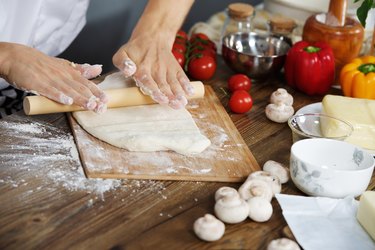
Don't expect your home-baked pizza to come out exactly like a pizzeria pizza. Unless you have a wood-burning stove, chances are your oven just doesn't get hot enough. However, you can expect a decently browned and crispy crust at home. A pizza dough that isn't browning was probably improperly prepared or cooked. Try raising the oven temperature as an initial strategy.
Recipe
Video of the Day
When making pizza dough, the dough should be soft and pliable, but never sticky. If the dough sticks to your hands or the rolling pin, add more flour. A dough that does not have sufficient flour is usually very soft and may not brown well.
Video of the Day
Preparation
Pizza dough, like all yeast doughs, benefits from raising time. After mixing and kneading the dough, place it on a floured surface and allow it to rise until almost double. If you skip this step, the dough may be flat and hard and may not brown well.
Bakeware
What you cook your pizza on can also have a bearing on how well it browns. True pizza aficionados use a pizza stone, an earthenware stone that transfers heat evenly for a crisp, browned crust. Otherwise, try cooking the pizza directly on the rack or buy a metal pizza pan with holes so the crust browns well. Pizza dough doesn't brown well or remains soggy in the middle when baked on heavy baking sheets.
Oven Temperature
Baking pizza is a real departure from baking bread and cookies. Your pizza might not be browning because the oven temperature isn't high enough. Heat your oven to 500 degrees Fahrenheit to quickly cook and brown it. Pizza dough needs to be slightly chewy to support a bevy of toppings. Cook it at a more moderate temperature and it stays soft -- and may not brown adequately.